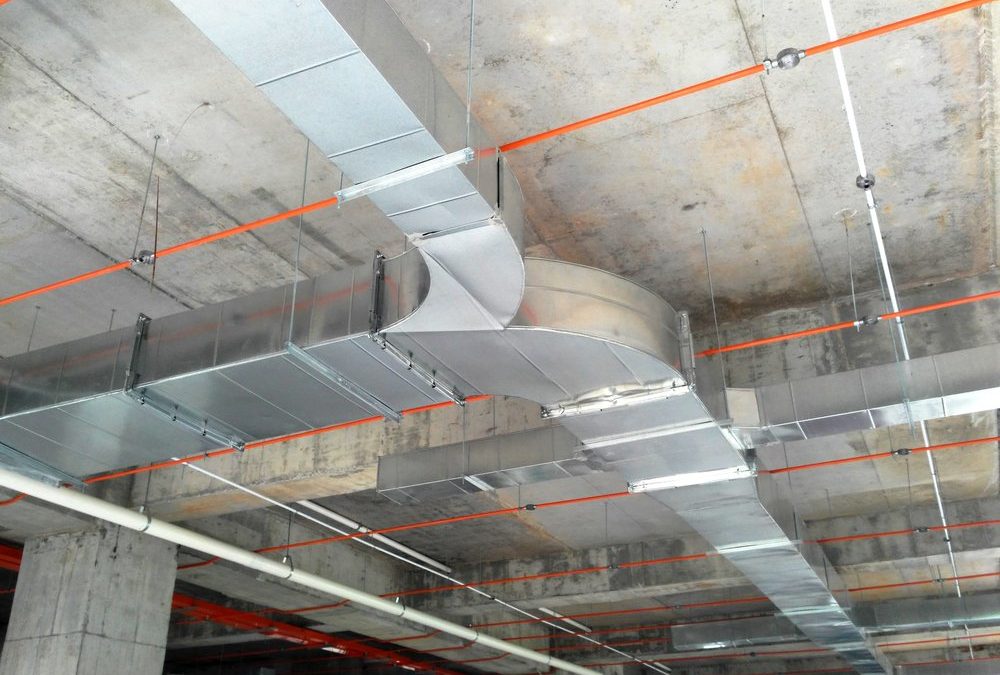Flexible Ducts:
The material composition of flexible ducts, often called flex ducts, is a mix of plastic and metal wire coil. Their extreme malleability makes them ideal for use in difficult or confined areas. Their adaptability makes them a favorite among remodelers and retrofitters who face challenges installing more conventional, restrictive ducting. Flexible ducts are convenient, but they aren’t without their downsides. Their tendency to bend and crush reduces system efficiency by cutting off airflow. In addition, they don’t insulate as well as rigid ducting, which means they could lose energy and perform worse if not placed correctly.
- Installation: In tight quarters or with a complicated configuration, flexible ducts are a breeze to install. Be careful not to make any sharp turns or kinks, as this can cut off airflow. Sagging and heat loss can be prevented with the right insulation and support.
- Maintenance: It is important to routinely check flexible ducts for any indications of wear and tear, including tears, punctures, or compression. For optimal thermal efficiency and air quality indoors, clean or replace the insulation as required. Make sure all of the connections are tight and airtight.
Rigid Ducts:
Durable and providing better airflow than flexible ducts, rigid ducts are usually constructed of galvanized steel, aluminum, or fiberglass. They are available in a variety of designs, such as circular, rectangular, and oval, enabling flexible installations to accommodate varied building layouts. The durability and resistance to airflow restrictions of rigid ducts make them a great choice for commercial and residential buildings that will be used for an extended period. To guarantee a good fit and maximum performance, though, thorough preparation and accurate measurements are required before installation.
- Installation: Proper fit and alignment of rigid ducts are essential during installation, which necessitates exact measurements and careful preparation. To keep duct parts from moving about and to reduce noise and vibration, use the right fasteners and supports. Use mastic or metal tape to seal seams and joints so air doesn’t get in.
- Maintenance: It is important to check rigid ducts for damage, rust, or corrosion on a regular basis. Remove any build-up of dust, dirt, or mold from the inside of the ducts in order to restore proper airflow and air quality. To keep the system running efficiently, fix any insulation damage or leaks very away.
Fiberglass Ducts:
Composite materials, such as fiberglass-reinforced plastic (FRP), are used to build fiberglass ducts. They reduce heat loss and transmission significantly due to their outstanding thermal insulation qualities. Many HVAC projects can benefit from using fiberglass ducts since they are inexpensive, lightweight, corrosion-resistant, and easy to install. The ability of fiberglass ducts to withstand moisture and microbial growth is a major benefit, as it aids in the preservation of indoor air quality by preventing the growth of mold and mildew. To avoid air leakage and maximize energy efficiency, however, it is crucial to install insulation and seal cracks properly.
- Installation: The installation process is made easier with fiberglass ducts because they are lightweight and easy to handle. If you want to keep heat in and moisture out, you need to seal and insulate the duct sections. To avoid sagging or distortion, make sure to follow the manufacturer’s instructions about the spacing of supports and the methods of attachment.
- Maintenance: Keep an eye out for mildew, water damage, or deteriorating insulation in fiberglass ducts on a frequent basis. To preserve the insulation and protective coatings, clean the duct surfaces gently. Maintaining thermal efficiency and indoor air quality may be as simple as repairing or replacing broken components as needed.
Fabric Ducts:
The breathable fabric materials used to make fabric ducts include nylon and polyester. They are also called textile ducts or air socks. Fabric ducts, in contrast to conventional ductwork, disperse air through thousands of microscopic holes all over their surface, resulting in a consistent airflow pattern across the room. Reduced installation time and cost, greater aesthetics, and customized airflow distribution are just a few of the many benefits that fabric ducts offer over conventional ductwork.
They are ideal for uses where cleanliness and hygiene are of the utmost importance because they are lightweight and easy to clean. Fabric ducts have their uses, but they might not work in places with a lot of humidity or airborne pollutants.
- Installation: In order to install fabric ducts properly and ensure that airflow is distributed uniformly around the room, specialist suspension systems are needed. Consider the manufacturer’s advice while planning the layout, selecting the suspension components, and determining the patterns of airflow distribution. If you want your fabric ducts to work at their best, you should check their tension and alignment on a regular basis.
- Maintenance: Periodically, use mild cleaning chemicals and follow the manufacturer’s instructions to wipe off fabric duct surfaces. Eliminate any build-up of dust, filth, or microorganisms that may affect the airflow or interior air quality. For optimal system efficiency and cleanliness, replace old or broken fabric duct portions as soon as possible.
Factors to Think About When Choosing a Duct Type:
The following considerations are crucial when choosing air ducts for an HVAC system:
- Building Layout: Find the best duct type for airflow distribution by analyzing the building’s layout and design.
- Performance Requirements: To choose ductwork that works for the system, think about things like airflow volume, temperature control, and IAQ.
- Budget: Finding the right balance between initial investment and long-term energy savings and durability is important when determining the available budget for ducting construction and maintenance.
Environmental Conditions: When deciding on duct materials and insulation, it is important to consider environmental considerations including humidity, temperature fluctuations, and exposure to pollutants.


